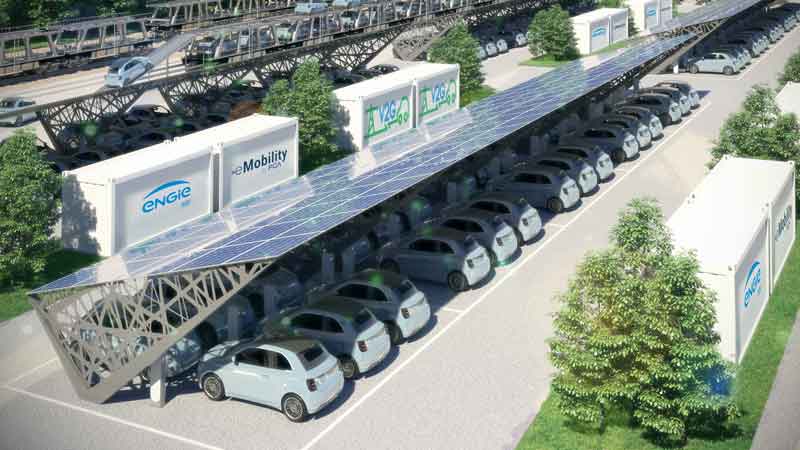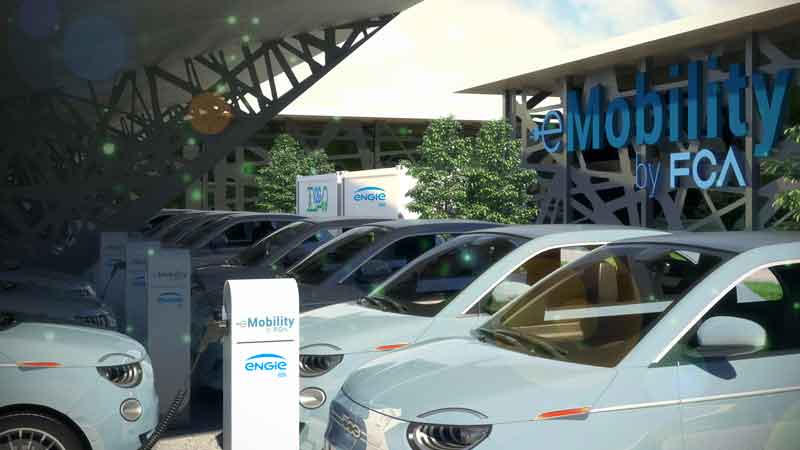Fiat Chrysler is forging ahead with a massive plan to test hundreds of electric vehicles interacting with the electricity grid in one location, as Italy emerges from an extended period of immobility in its bid to flatten the Covid-19 infections curve.
Vehicle-to-grid technology, otherwise known as V2G, has the potential to support the electricity grid by utilising bidirectional charging capabilities to channel power back to the grid to smooth the curves of high and low electricity demand, and to provide essential grid services.
It is estimated that by 2025, Europe will be producing some 200GWh capacity of electric vehicle batteries per year, and as the electric vehicle industry grows so too will the need to balance these resources as they interact with the grid.
The vehicle-to-grid pilot project that will be conducted by Fiat Chrysler Automobiles (FCA) and Engie Eps, the energy storage and microgrid division of French utility giant Engie. It hopes to establish the balancing characteristics of V2G technology to underpin a grid increasingly powered by renewable resources.
Located in Mirafiori, home of Italian auto brand Fiat in Turin, Italy, construction of the site for phase 1 of the pilot project has now commenced, covering a 3,000m2 area that will consist of 32 V2G columns that will service 64 electric vehicles once it is completed in July.
By the end of 2021, FCA intends to extend the facility to house up to 700 electric cars, capable of supplying up to 25MW of electricity, to become what is thought will be the largest such facility on the planet.

As Roberto Di Stefano, head of EMEA e-Mobility at FCA points out, the opportunity to take advantage of electric cars to help stabilise the grid they are parked for most of the time is immense.
“The project is acting as our laboratory to experiment on and develop an offering to add value in the energy markets,” said Di Stefano in a statement.
“On average, cars remain unused for 80-90 percent of the day. During this long period, if connected to the grid by Vehicle-to-Grid technology, customers can therefore receive money or free energy in exchange for the balancing service offered, without compromising their mobility needs in any way.
“In addition, this project forms part of a broader context of the technology partnership that has stood between ENGIE Eps and FCA since 2016. The main, tangible objective of this partnership is to reduce the cost of FCA electric vehicle lifecycles, via specific offers exclusive to our customers,” said Di Stefano.
Carlalberto Guglielminotti, CEO of Engie Ep, says that there is an opportunity in V2G, particularly for fleets.
“During this period of forced immobility in Italy, we are continuing to build the country’s future in partnership with FCA, by developing the technology required for the electricity grid to support the deployment of electric cars. At the same time, the project will also help to stabilize the network,” said Guglielminotti in a statement.
“Estimates have it that by 2025, the total storage capacity of electric vehicles in Europe will be over 300 GWh, representing the largest distributed resource available to the European energy system.
“The market for V2G infrastructure, to date consisting almost exclusively of experimental projects, is now ready to get off the ground. The Drosso project at Mirafiori is a world first. We are confident that it will soon be joined by a solution for all company fleets.”
Japanese car maker Nissan is already utilising V2X technology with its Nissan Leaf and is undergoing certification for its use in Australia to supply power to homes.
Nissan is also working on a plan with French energy utility EDF Group to develop smart charging solutions including V2G services.
A recent report suggested that Tesla is also integrating V2G technology in its vehicles, although it has since been refuted.
RenewEconomy and its sister sites One Step Off The Grid and The Driven will continue to publish throughout the Covid-19 crisis, posting good news about technology and project development, and holding government, regulators and business to account. But as the conference market evaporates, and some advertisers pull in their budgets, readers can help by making a voluntary donation here to help ensure we can continue to offer the service free of charge and to as wide an audience as possible. Thankyou for your support.

Bridie Schmidt is associate editor for The Driven, sister site of Renew Economy. She has been writing about electric vehicles since 2018, and has a keen interest in the role that zero-emissions transport has to play in sustainability. She has participated in podcasts such as Download This Show with Marc Fennell and Shirtloads of Science with Karl Kruszelnicki and is co-organiser of the Northern Rivers Electric Vehicle Forum. Bridie also owns a Tesla Model Y and has it available for hire on evee.com.au.

